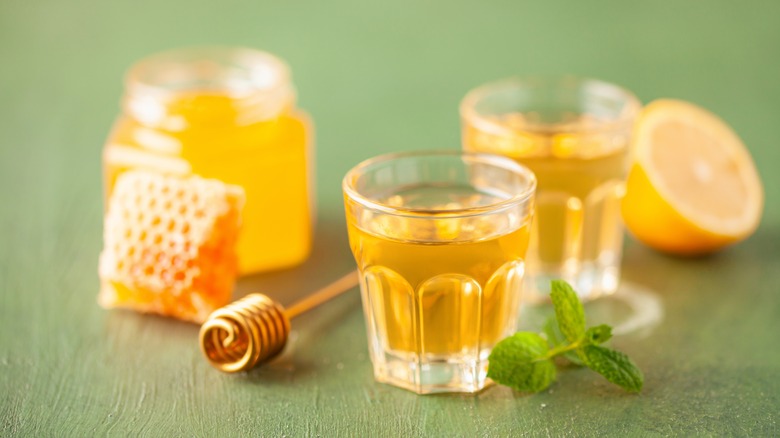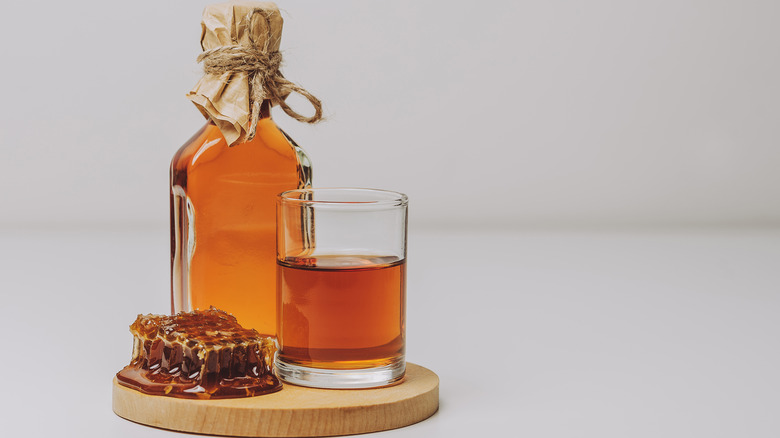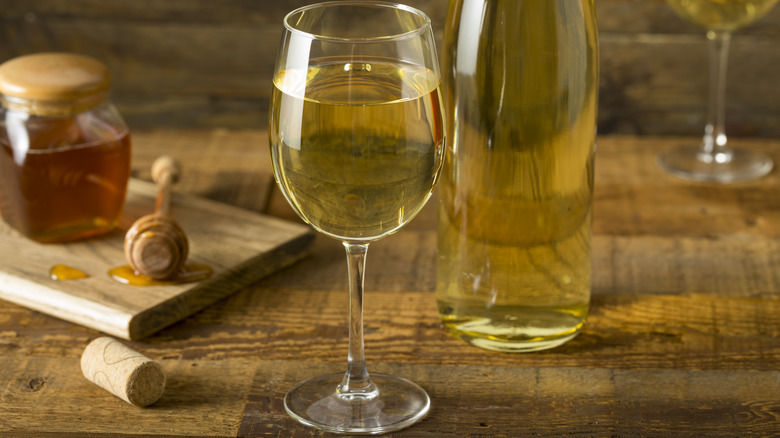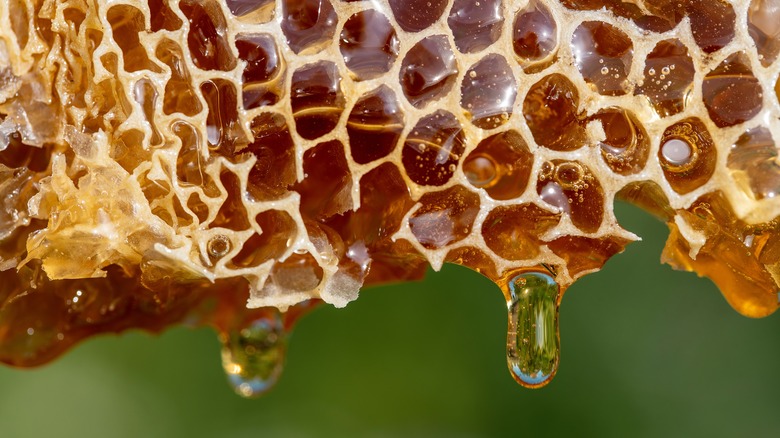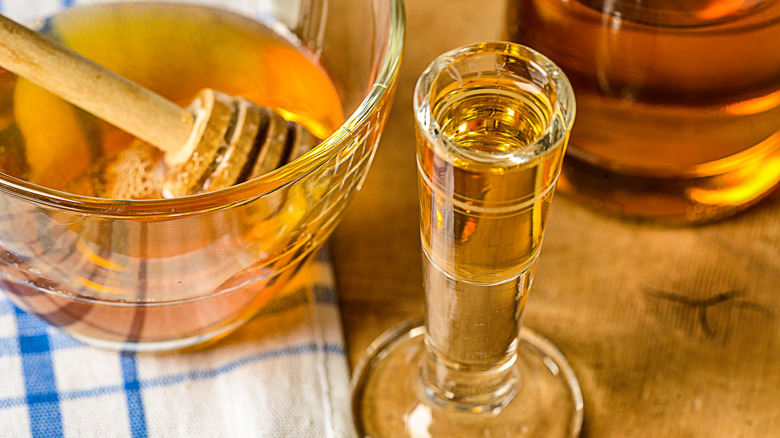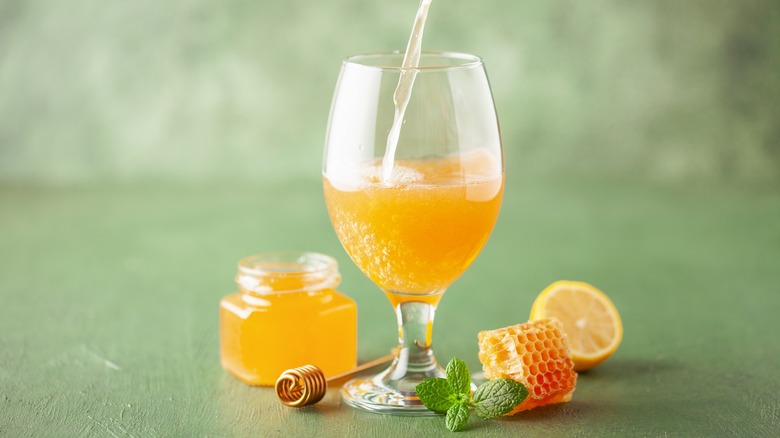What Is Mead And How Do You Drink It?
Mead's popularity has surged in recent years, making it seem like a new addition to the category of undistilled alcohol. Benefiting from the global craft beverage movement, mead has slowly joined the ranks of other alcoholic beverages such as beer, wine, and cider on bar menus. Some might even credit books like "Harry Potter" and shows like "The Witcher" for reviving the drink that many had not heard of before — mead was popular among witches, wizards, and the general populace of both fictional worlds.
However, this amber-colored liquid is no new invention. On the contrary, it's believed to be the oldest alcoholic beverage in existence — the first potent tipple that humans ever sipped on. Named after the Old English words medu or meodu, which mean "fermented honey drink," mead is just that: an alcoholic beverage made from a base of honey, water, and fermented using either yeast or bacterial cultures.
From there, the golden drink can be flavored with all kinds of herbs, fruits, spices, flowers, roots, and grains. Depending on how it is made and what it contains, mead's alcohol content can range anywhere between 5% to 20%, with some versions containing as little as 3.5%. As such, meads can be consumed much the same way as beer or wine.
Mead is an ancient drink steeped in history
Mead is a drink so ancient that it's unclear who invented the drink or how it came to be. Tracing the timeline of its existence is even more convoluted because the golden elixir is mentioned in texts across several civilizations during different periods. But the earliest evidence of mead dates back to 7000 B.C. in China. The discovery of pottery jars in the northern part of the country indicates the existence of a drink made from honey, rice, and wild grapes nine millennia ago.
However, some historians claim that mead is even older, and was a staple among African tribes living 20,000 to 40,000 years ago. Regardless, the general consensus is that the amber liquid was discovered entirely by accident, after ancient settlers sipped on honey produced from beehives that were likely fermented by yeast-filled rainwater.
No matter how mead came to be, it's clear that it was a wildly popular drink across borders. Mead was a staple in early Greek and Egyptian civilizations, and the Vikings, too, were known to have a penchant for it — the honeyed liquid was an important part of religious rituals, celebrations, and an indicator of one's status in the community. Mentions of soma (an ancestor of mead) exist in the "Rig Veda," an ancient Indian text; mead has been referenced in Norse mythology; the works of Aristotle and the Welsh poet Taliesin feature the drink; and it's also mentioned in the Old English poem, "Beowulf."
Mead was treated as a healing elixir and an aphrodisiac
Far from just another alcoholic beverage, mead held great value in ancient cultures. Bees were considered messengers of the gods in European mythology, so the honey they produced — and subsequently the mead — was immensely important. The ancient Greeks thought that mead was drops of dew sent by the gods from heaven.
As humans began to drink mead, they also believed it had aphrodisiac properties. During medieval times, newlyweds would be gifted enough mead (or honey wine, as they called it) to last a full moon cycle, ensuring a prolific marriage in the months to come. This ritual of drinking honey wine for the first month of marriage gave birth to the term "honeymoon!"
Many cultures also drank mead as a medicinal potion for its purported health benefits. Greek warriors used it as a healing elixir, and fermented honey blended with leaves and herbs is mentioned as a treatment for skin conditions and leprosy in ancient Ayurvedic texts. England also has a history of infusing herbs and spices to make a mead tonic labeled as metheglin. Named after the Welsh word for physician, the concoction was used to soothe hypochondriacs, and prescribed to those suffering from symptoms of depression or indigestion. Although the health benefits of fermented honey are debated in modern research, it was certainly held in high regard throughout history.
How is mead made?
Mead is often mistakenly categorized as wine, perhaps because it is made using a similar process as fermented grape juice. Water is added to thin and dilute honey, after which yeast or bacteria ferments the liquid, and turns the sugar inside into alcohol. The proportion of these three ingredients shapes mead's alcohol content, and the liquid is then left to age for added complexity.
But where wine is commonly made from grapes, mead is made primarily from honey. Although fruits can be added to flavor the drink, at least 60% of the drink must be comprised of fermented honey for it to be classified as mead. While many continue to refer to mead as honey "wine," the term more often refers to wine that has been sweetened with honey instead.
The way mead is made, or more specifically the ingredients used in its making, is also the reason why it fell out of popularity before its recent resurgence. For one, honey itself is not easy to produce, and early humans didn't have the modern-day equipment used to gather honey from bees safely. Simultaneously, sugar produced in the West Indies became a prevalent sweetener in the 17th century, rendering beekeeping and honey-making a rather unnecessary risk. The discovery of converting the sugar from malt and grapes into alcohol to produce beer and wine put the final nail in the coffin for mead, slowly pushing the honey-based drink out of the picture until recently.
Mead's flavor depends on several factors
A great many factors can influence mead's flavor. For one, there's the honey to consider; much like different types of grapes influence the character of a wine, the type of honey used will play a role in the mead's ultimate flavor. Then, there are different styles of mead — they can be still or sparkling, and sweet or semi-sweet.
In fact, while you might expect all meads to be laced with honey's syrupy flavor, there are dry versions that aren't sweet at all. Crisp like Champagne, dry meads use honey in quantities so low that all of the sugar ferments into alcohol, leaving nothing to actually sweeten the drink. In some cases, even sweet and semi-sweet meads use a method known as back-sweetening — where more honey is added at the end of fermentation to bring the sweetness.
Meads also get their flavor from additional ingredients. Traditional meads with just honey and water will have a smooth sweetness akin to white wine with a hint of acidity. On the other hand, fruit-infused meads known as melomel take on the flavor of the fruits used. Bochet meads made from caramelized honey have notes of toffee and caramel, capsicumel meads pack the heat of chilies, and omphacomel meads boast a sour tartness from unripe grapes. There are also pyment and braggot meads — the former uses grapes to make a wine and mead hybrid, whereas the latter is made from a blend of grains, and is half-beer.
How to drink mead
To put it simply, mead is as easy to drink as beer, cider, and wine. It can be consumed straight from the bottle, or poured into a glass. However, it's not unusual for mead to be appreciated the way wine is. Once the mead is poured into a stemmed glass, the liquid is usually swirled to allow drinkers to inhale its scent. The next step is to take small sips of the beverage and roll it around in your mouth each time. As the drink lingers on your tongue, the full extent of its flavor will develop.
Mead can also be served warm or chilled. The ideal temperature for cold mead is approximately 52 to 60 degrees Fahrenheit, but one thing to keep in mind is that the chilled temperature will inhibit your ability to fully savor the mead's nuanced flavor profile. This is why sweet or light-colored meads are more suitable for drinking cold. If you're going to consume a strong mead that you've stored in the refrigerator, make sure to take it out at least half an hour before drinking to allow its taste and texture to blossom.
Mead can be mulled and heated up to between 122 to 131 degrees Fahrenheit for a sweeter and more caramelized flavor — but any hotter, and its flavor and aroma will quickly evaporate. Meads are also versatile enough to be turned into cocktails — think mead mimosas, mojitos, and even sangrias.

